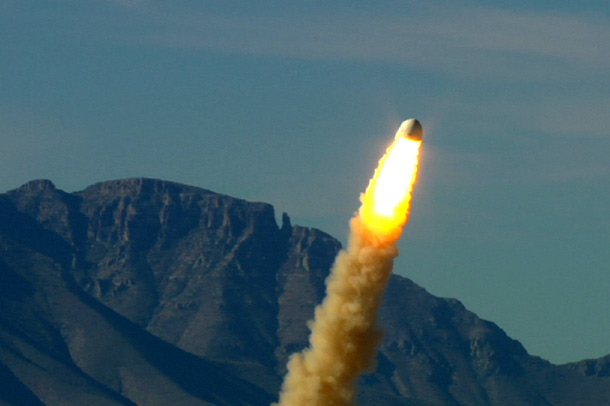Create a free profile to get unlimited access to exclusive videos, sweepstakes, and more!
Blue Origin successfully tests its crew escape system

Reliance on American vehicles to take humans back into space took another step up over the weekend, when the private company Blue Origin - founded by Amazon.com's Jeff Bezos - successfully tested their crew escape system.
Putting people in space isn't easy, and is fraught with danger. NASA requires that, in the case of an emergency, there is a proven escape system for the crew in case the rocket underneath them goes kablooie. One reliable system is to have a small solid rocket above the crew capsule that can pull it away to safety (which is how it was done for Apollo).
Interestingly, the Blue Origin method is to use a rocket underneath the capsule, so they call it a "pusher". Unlike other methods, this rocket is reusable, a technology NASA likes to explore. It lifted a full-scale suborbtial crew capsule to a height of 700 meters (2300 feet) and carried it 500 meters (1600 feet) downrange.
I couldn't embed the video of the launch, but you can see it at the Blue Origin site. I recommend it. It's pretty cool.
Blue Origin is notoriously secretive about what they're working on. They have a crew capsule, and they're working on an unmanned suborbital space vehicle called New Shepherd. They have their sights set on orbital flight, but it's not clear exactly how they're going about doing that. Currently, plans are to use an Atlas V for launching vehicles. However, just last week Blue Origin successfully tested a rocket engine they're developing, and it's obvious this is what they hope to eventually use to get to orbit.
Currently, the only private company that can go to space is SpaceX - their Dragon capsule is still berthed to the space station as I write this - but it looks like they won't be alone for long. Sierra Nevada, another company, is also working on a suborbital vehicle called
Lynx Dream Chaser [oops! Got the name mixed up originally; Lynx is the XCOR spaceship] with an eye to orbit.The more the merrier. With better tech, and competition, the price for getting to space will drop, and accessibility will go up. Some people wonder why I'm optimistic about space exploration in the near future. Well, here you have it. NASA can save a lot of money contracting out to these and other companies. If these plans go well, in ten years, maybe less, the face of space travel will have changed dramatically.
Related Posts:
- Space Leap of Faith
- History is made as Dragon splashes down safely in the Pacific!
- Discovery makes one final flight⦠but we must move on.
- Debating space



























